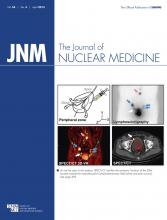TO THE EDITOR: Our group was quite surprised to review the findings published in The Journal of Nuclear Medicine by Fiechter et al. (1), who reported poor diagnostic quality for a cadmium-zinc-telluride (CZT) camera with pinhole collimation (Alcyone; GE Healthcare) in very morbidly obese patients (body mass index [BMI] ≥ 40 kg/m2). Image quality was reportedly nondiagnostic in 81%, a strikingly high level of inadequate diagnostic performance that was marginally decreased to 55% by the use of CT-based attenuation correction in this important population. Also puzzling is their finding that rescanning very obese patients on a conventional NaI SPECT camera improved diagnostic image quality in superobese patients (BMI ≥ 45 kg/m2), a population whose diagnostic accuracy by SPECT is widely recognized to be highly problematic because of false-positive results associated with attenuation artifacts.
In our initial 8-wk experience at the University of Rochester Medical Center, CZT SPECT myocardial perfusion imaging (MPI) with the D-SPECT system (Spectrum Dynamics) in very morbidly obese (≥40 kg/m2) and superobese (≥45 kg/m2) patients has been associated with highly reliable diagnostic-quality images for detection of coronary heart disease. The D-SPECT uses parallel-hole collimation for imaging, and our routine protocol is to acquire a minimum of 1 million counts in the left ventricular (LV) region of interest (ROI) for both supine and upright stress and rest images. We use the same quantitative perfusion/gated SPECT image software used by the Zurich group.
We have successfully imaged, without a routine rescanning requirement, 27 consecutive patients with a BMI higher than 40 kg/m2, 21 of whom (78%) have given prospective signed consent to our Research Subjects Review Board to track their findings. Of these 21 patients, all had diagnostic-quality images, which were judged by a highly experienced nuclear cardiologist to be excellent in 9 (43%), very good in 10 (48%), and fair in 2 (9%). Five patients (24%) had a BMI higher than 50 kg/m2. Eight of these patients (38%) exceeded 320 pounds, the weight limit of our traditional NaI Sopha DST dual-head SPECT system.
Several factors may account for the striking difference observed in reliable diagnostic imaging of very morbidly obese patients on these 2 different CZT camera systems in Zurich and Rochester: the type of collimation (pinhole vs. standard parallel-hole), count density in the LV ROI, gantry size and configuration to accommodate rapid positioning and imaging of very morbidly obese patients, and routine use in virtually all patients of supine and upright imaging to facilitate recognition of attenuation artifacts.
The conclusions of the Zurich group that CZT γ-cameras do not work well and should not be used in very morbidly obese patients (1) do not appear justified. We question whether our colleagues in Zurich have fully considered the limitations imposed by pinhole collimation and gantry configuration on their need for reimaging and the prevalence of nondiagnostic studies. In our initial experience, CZT detectors in the D-SPECT camera provide good to excellent imaging results without the need for routine reimaging in most very morbidly obese and superobese patients. Our experience demonstrates clear advantages and no intrinsic limitations of CZT detectors compared with NaI detectors in the morbidly obese population. Evaluation of the diagnostic accuracy of quantitative upright–supine high-speed CZT SPECT MPI compared with invasive coronary arteriography using validated quantitative software (2) appears warranted in morbidly obese patients.
On the basis of our initial 8-wk prospective experience with the D-SPECT system, we conclude that in virtually all very morbidly obese and superobese patients, high-diagnostic-quality images that have a high count density in the LV ROI are routinely achievable using CZT SPECT MPI with parallel-hole collimation and an open gantry that permits rapid supine and upright imaging to aid identification of the attenuation artifacts common in this population. A further multicenter study appears indicated to evaluate the reliability and diagnostic accuracy of CZT SPECT MPI with parallel-hole collimation for known or suspected coronary heart disease in this clinically important population that has been underserved by routine SPECT MPI and by other imaging modalities because of major limitations of diagnostic quality and accuracy.
Footnotes
Published online Jan. 31, 2013.
- © 2013 by the Society of Nuclear Medicine and Molecular Imaging, Inc.







